Introduction
‘Prospect-Refuge’ (1975) is a theory or sub-theory of landscape aesthetics proposed by the human geographer Jay Appleton (1919 – 2015), within his wider thesis called ‘Habitat Theory’. These theories, and those related theories of ‘Information Processing’ (1989) proposed by the husband and wife team of environmental psychologists, Rachael and Stephen Kaplan have unquestionable merit for landscape and garden design application!
Synopsis
In brief ‘Prospect-Refuge’ theory is founded on the notion that we seek out opportunities to: perceive and acquire visual information, to explore environments, and find opportunities (prospect); and to seek out: shelter, protection, and environments where one can hide away (refuge). Although not present in the theory title Appleton talks also about hazard. Hazard is defined by Appleton as: ‘the proximity of something which threatens, menaces, or disturbs our equilibrium.’
We can condense this whole theory of prospect-refuge down to an imperative to see without being seen, and a desire to be comfortably ‘safe’. Appleton subscribed to zoologist and ethologist, Konrad Lorenz’s (1903 – 1989) notion of ‘to see without being seen.’
Ethology is the study of animal behaviour and Lorenz noticed this trait demonstrated by predators. Predators need to find places in the environment where they can see without being seen. Though not entirely so, human beings are at least part predators. I would like to think that human beings have stopped predating, but unfortunately nothing could be further from the truth, however our modern-day predation, aside from being vile since some human’s prey on other humans, is also very complicated from a social perspective and a simple example is required here.
A Predator Example
So, I have arbitrarily chosen the African savannah habitat as a simple illustration of the prospect-refuge concept. Using an example from the African savannah we can see that lions congregate under the shade of Acacia trees and thus are concealed in the shadow of the Acacia trees from creatures in the open. Aside from providing the lions with comfort the shade causes occlusion at a distance because of the intense contrast between the bright sunlight in the open savannah. ..

Zebras however, who are grazing in the open savannah can’t see the lions because of this stark contrast between the light and shade. Thus, the lions can see, but they themselves cannot be seen, i.e. they have prospect-refuge, and the premise is that this opportunity gives them an advantage. For these same survival reasons, it is postulated by Appleton that primal man is also predisposed psychologically to like places where they can see without being seen, i.e. prospect-refuge, because their survival in environments like the savannah also depended on it. In addition humans like the cat family seek out comfort as much as it is afforded.
A Prey Example
Zebras also like to shelter under the shade of Acacia trees…
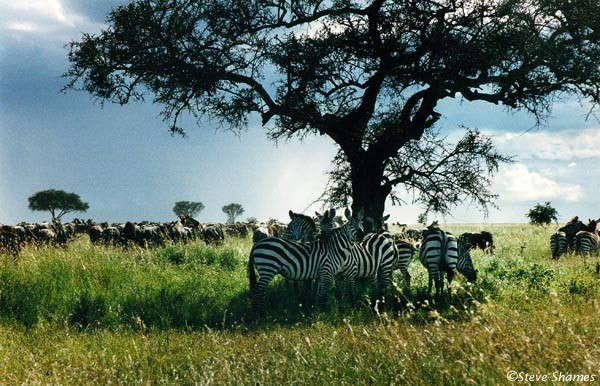
We can see that there are two imperatives at work here. The desire to see without being seen, and a desire for comfort, in this example relief from harsh environmental conditions. There is not much in the way of shelter in the savannah except these sparsely dotted shade trees, so as a habitat resource for exploitation it is limited.
The resource however, has more than one particular function that can be exploited by both predators and prey: shade leading to physical relief, and shade leading to environmental concealment without loss of environmental awareness. Its dual function is thus integrated around a common denominator – shade. These same benefits applied to humans who lived in the savannah as well as to animals and so forms part of our deeper psyche. In addition the form of these Acacia trees that gives rise to the beneficial shade (concealment and shelter) is aesthetic to the human eye. It offers interesting visual relief from the otherwise monotonous savannah. Now we can see that its dual function from the perspective of both predator and prey creatures is arising from its shading potential, which is thus actually an integrated consequence of its wide spreading botanical form. This to me is integrated design. Therefore, I would like to suggest that integrated design is what we need to do to create good prospect-refuge for human enjoyment in all designed landscapes that have the space to embrace it.
Integrated Design
What separates pure art from design is functionality. Landscape designers, architects, interior designers, engineering designers, product designers and even graphic designers all attempt to practice integrated design. The desirable objective is a marriage between functionality and aesthetics. The measure of a master designer above a mediocre one is simply his or her ability to creatively synergize more functionality with more beauty. Synergy means to combine or coordinate the activity of (two or more agents) to produce a joint effect that is greater than the sum of their separate effects – a Gestalt solution….
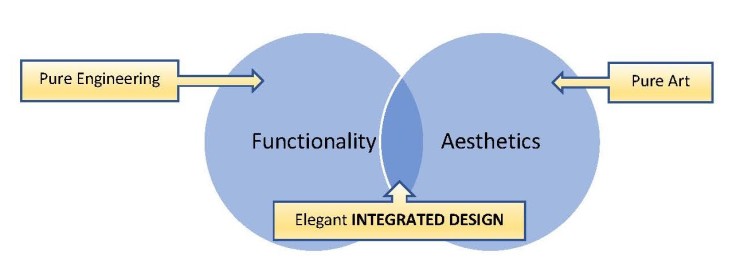
For example, humans have had a fundamental need to boil water. In Asia water has been boiled for millennia, and this allowed it to be made potable since the water born bacteria had been killed. The everyday kettle had a much cruder origin, but through years of human orientated integrated design effort the kettle has also now emerged as a work of art. We could cite the architectural maxim of ‘form follows function’ here with ease…

I therefore contest that prospect-refuge is exactly that: functionality fused with beauty.
Understanding Prospect-Refuge
To create pleasing prospect-refuge in designed landscape it is beneficial to understand how it is created in the natural world. We can analyse the benefits of each naturally occurring prospect-refuge and see how landscape design utilises this.
In the savannah, prospect-refuge is created by wide spreading shade trees…

In landscape design speak this creates a partial ceiling plane. The ceiling plane creates dappled shade from overhead sun, and has a cooling effect, while allowing air movement. The landscape features known as pergolas and arbours are a contrived application of this concept, but there are no shortage of wide spreading shade trees to fall back on if the pergola doesn’t fit the bill.
An extension of the lone savannah tree concept – woodlands, also offer stronger opportunities for prospect-refuge on their fringes, and with the ability to move unseen within the woodland to another prospect-refuge they obviously have a tactical advantage in times of conflict. The English legend of Robin Hood played on this, since it is known that the Norman invaders were afraid of the woods, and so they represent perfect prospect-refuge from the notion of defensible space. Anyone in the woodland can see all, but anyone in the field outside cannot see them.

The pleasurable aesthetic however is born of the enframement of the pleasing view and the sharp contrast between light and shade, as any artist will tell you. The photograph above shows this perfectly – how many times have you seen views like this painted?

The fact that we find all this ‘attractive’ has nothing to do with survival, that’s the functional side of the integrated design. I am sure it was just as attractive to Robin Hood then (if he really existed,) as it is to us now. I am sure that if Robin took Maid Marion for a walk he choose places like this as much for the romantic aesthetic, and the opportunity for privacy with his lover, as he did to keep out of sight of approaching Normans!
In hilly or mountainous regions prospect-refuge is afforded by an elevated (refuge) point, allowing views (prospects) below and all around. ..

In the image above we have an elevated refuge to a valley prospect augmented by a woodland copse.
The many perched villages of the Cote d’Azur, France are a human extension of the concept of elevated prospect-refuge, which obviously did originate with the survival ethos. Below is St Paul de Vence, Provence, France…

In times of conflict the perched villages were very defensive allowing invaders to be seen quickly. Invaders wanting to conquer were also disadvantaged because by the time they got to the summit (assuming they made it that far under the rain of arrows and other life-threatening projectiles,) they had already expended large amounts of energy and were partially exhausted before they got into hand to hand combat.
The aesthetic afforded by these hilltop elevations are however splendid, and it attracts many artists of renown. Any present day walk through Eze village, or St Paul de Vence in Provence reveals this – the modern-day artists are everywhere, and the views can explain this with no further convoluted deliberation. That is why Chagall, Matisse, Picasso, and Leger all lived in St Paul de Vence for example.
The splendid view below of the Mediterranean is from Eze village with the peninsular of St Jean Cap Ferrat in the distance…

There is now another desire at work in the perched villages of Provence – commercial gain. Here below is a night-time view from La Chèvre d’Or, an exclusive very hip restaurant and hotel perched high up right on the cliff of Eze village overlooking St jean Cap Ferrat, and frequented by the rich and famous…

Great panorama and intimately romantic to boot, all at a price, here’s the menu: 85 € (weekday lunch), 150/250 € – Carte 200/270 € per person and the recognised and expected tip for the waiter is 20% above the meal cost. The menu states that one can select from the ‘interesting’ wine list and no doubt expect similar ‘interesting’ prices per bottle as well.
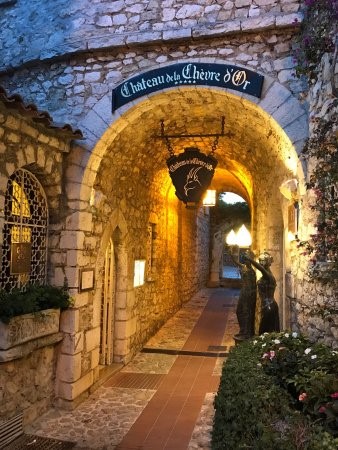
La Chèvre d’Or translated from French means ‘The Golden Goat’, now I wonder why they called it that? Appleton was right about the seeking out of opportunities, or ‘what’s in it for me’ as he put it, here we see prosperous-refuge in motion!
Caves are another natural prospect-refuge. Here we not only have the occlusion in the refuge by means of shade, but we have total enclosure on three sides and a complete ceiling plane, which will create human comfort of a kind. ..

When the Israeli warrior King David was hiding from the madman Saul who was intent on killing him, he frequented the mountain caves in order to elude him. So yes of course caves are defensible, just like Eze or St Paul de Vence, but its beauty afforded by the prospect is also stunning, and has nothing to do with defensiveness, it has to do with aesthetic view enframement and light contrast. The cave above is in Crete and let’s not forget that in the Mediterranean the shade is very important otherwise it is unpleasant in full sun exposure during summer, so comfort does also come into the equation.
The landscape garden grotto is an expression of this natural cave prospect-refuge aesthetic. Below is the grotto at Stourhead Gardens in Wiltshire, UK…

Below the grotto in Stowe Landscape Garden, Buckinghamshire, UK…

Below the amazing grotto at Parque Terra Nostra at Furnas in Portugal…

From these examples above we can easily analyse the elements that create the prospect-refuge aesthetic and functionality……
• REFUGE: Shade provided from overhead canopy, and thus obscurity, ie wide spreading tree;
• REFUGE: Enclosure or partial enclosure and again obscurity and comfortable shade, ie a cave or a woodland;
• REFUGE: Altitude and once more obscurity, ie mountains and hills.
• PROSPECT: One or more beautiful vistas visible from the refuge;
• PROSPECT: One or more beautiful panorama visible from the refuge;
Creating Secure Space
In professional landscape design speak we refer to: ‘secure spaces’, ‘active and passive spaces’, and to ‘sense of place’ (see my other essays on these subjects for more explanation). Secure space in landscape and garden design is effectively what prospect-refuge is in the natural world, but both are arguably ‘integrated design’. Secure space creates psychological comfort and it also creates privacy. By a deliberate and conscious effort to carry out integrated design we can create secure comfortable aesthetic space – the ‘refuge’ part, with delightful interesting vistas and panoramas – the ‘prospect’ part.
Active space is space that incites movement or transition, while passive space incites repose, and this is important in reinforcing a prospect-refuge. We want the refuge space to incite repose and the prospect part to incite exploration. Sense of place is also important to elevate both the space to something almost ethereal. Thus, the arrangement of these elements is a part of the overall landscape design composition. They can be designed in any given form arrangement: formal symmetric, formal asymmetric, or informal.
The aesthetic and practical weight of the secure (refuge) space increases as we: integrate more and more elements that give rise to physical and psychologic comfort, improved functionality, respose desirability, and greater aesthetic beauty. In the prospect space we conversely design it to incite movement leading to sequential journey. Here we see a complex synergy at work in both the refuge and prospect components of the composition.

In other words, we can intensify the ‘prospect-refuge’ of any designed space by how we design the spaces, and the careful choice, relationship and juxtaposing of the elements we use to do this, that is the composition.
Balancing the Duality
Prospect-refuge represent two different diametrically opposite kinds of space that have a strong connection, they are complimentary spaces – a duality in fact. We can easily overlay here the yin and yang cosmic symbol of duality to show the special relationship between prospect and refuge…

When one is in the prospect the refuge is desirable, it has a strong magnetism. Conversely when one is in the refuge the prospect is not only visually pleasing, it is desirable for exploration. We can see from this that prospect-refuge also plays a major role in driving the sequential journey, since desire is the basic human emotion at work in both. As designers we decide on the weight of magnetism we infuse into each part of the duality: the prospect and the refuge. Whether we choose to make the prospect more desirable than the refuge, or vice versa is a philosophical design decision that needs to be made at the design stage of each prospect-refuge. It is fairly safe to assume that the prospect will be more spacious than the refuge…
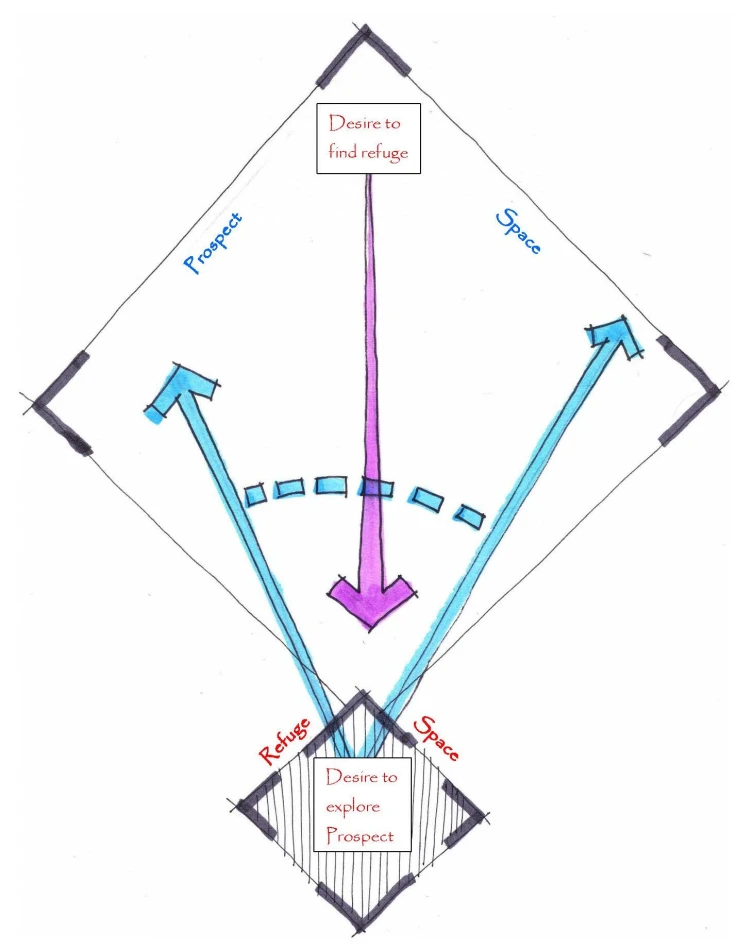
When talking about the ratio of relative desirability between the prospect and the refuge I am however not simply talking about the relative scale of the spaces, though that will of course play a part in the dynamic. I am talking about the relative interaction of all the various elements (‘hard’ and ‘soft’) that make up the prospect and refuge space. By skilful composition we can make one of either the prospect or refuge more desirable and thus we create a pleasurable asymmetric balance.
People will be psychologically influenced by all this. They will stay longer in a stronger refuge space, and less time in a weaker refuge space; they will also leave the refuge more readily to explore if the prospect has a greater strength, and stay in the refuge space longer if the prospect is weaker…
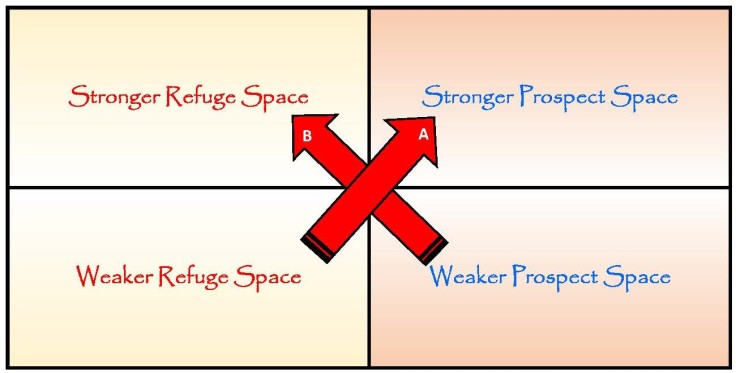
As a schematic example in the matrix diagram above we can see that combination ‘A’ greatly favours exploration of the prospect above repose in the refuge. Combination ‘B’ does the reverse and greatly favours repose in the refuge above exploration of the prospect. Like sexual attraction the dynamic is driven by the power of attraction to opposites.
It is also safe to assume that a large landscape, park or garden will have more than one prospect-refuge duality in the sequential journey, and for the sake of interest (or ‘complexity’ as the Kaplan’s put it,) it would be good to not have all of these different prospect-refuge dualities balanced the same. Returning to our metaphor of landscape design being like writing a book, that would be like having all the sentences, paragraphs and chapters the same length, with the quantity and level of excitement the same in each, along with a similar plot line. It might be a bit harsh to suggest this type of book would be boring, but it is safe to say it would be less interesting – not a best seller!
The Whole is Greater than the Sum of its Parts: the significant role of design composition
What then can we actually do to make the prospect-refuge better? We can reinforce and delineate the space with some kind of structural mass to make it stronger. This can be planting mass or architectural hard features, or both. If the structural mass is located to deflect or filter cold winds this makes the space more comfortable, which translates to desirability, because comfort is part of our sensory aesthetic. The structural mass also creates psychological security so long as we can see all the ways into the space.
We can create partial overhead celling planes with pergolas, arbores or light foliage trees to give comfort from hot sun and privacy from vantages above. The shade also creates the light and dark contrast that accentuates the ability to see without being seen, thus creating secure space. We can also use a complete ceiling plane as is created by a loggia. Loggias are typical elements within the architectural residences of Florentine villas in Tuscany, Italy…

In the typical Florentine villa above we can see that:
• The villa is situated on a hill giving good prospect-refuge;
• That the loggia on the ground floor has a complete ceiling plane creating shade, but is open through arched colonnades to allow the prospect of the garden falling down to the valley below;
• That the loggia is very psychologically secure space reinforced greatly by the door;
• That the contrast between the dark shade within the loggia and the bright sunlight outside is intense, thus creating a strong prospect-refuge.
This is a wonderful architectural composition of prospect-refuge. The loggia however would have had even greater prospect-refuge if it had been situated in the upper tower, but regardless the whole is greater than the sum of its parts – it is a Gestalt composition of note.
The Importance of Composition
Composition is therefore everything in the design of prospect-refuge, as it is in all matters of design. It is within the composition that the skill, experience and knowledge of the designer shows through, and indeed conversely the lack of good design composition is equally glaring to the trained eye. You cannot simply throw all the elements together at random and hope this work.
The integrated design is a deliberate and very skilled effort. There must be: harmony, balance, rhythm, complexity, legibility and appropriate scale and proportion, together with a strong sense of place. All of this must be infused within the refuge and the prospect, that may be only one chapter in the sequential journey – it is quite an undertaking.
LandARCHConcepts are experts in landscape design and we have designed and created many examples of prospect-refuge, or secure space. Below we have dissected a few spaces which punctuate the large sequential journey of Villa Malgaresh in the hills of the Cote d’Azure, France to illustrate an example the skilled composition of the elements that make the prospect refuge dynamic work. Below is a very strong refuge space with a weaker prospect space. The space sits at the end of the sequential journey around the garden and is thus close to the villa…
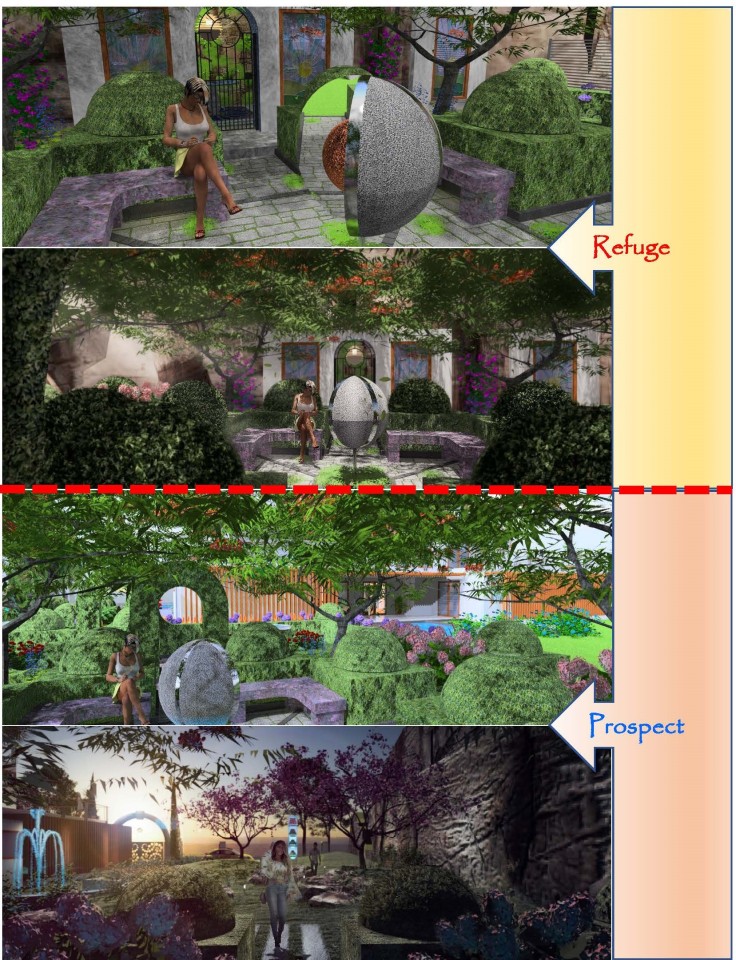
The villa is overlooked on one side by a neighbourhood property, so privacy for the Owner was an issue. We have four Albizzia trees in a formal arrangement creating an overhead ceiling plane and strongly enframing the sculpture which sits at the centre of the refuge space. The canopy of the trees also enframe the prospect.
In the landscape management phase of the design informal pruning will maintain a naturally looking small aperture in the leafy ceiling plane to allow just enough light to illuminate the sculpture during the day, thus intensifying its role as a focal point in the sequential journey.
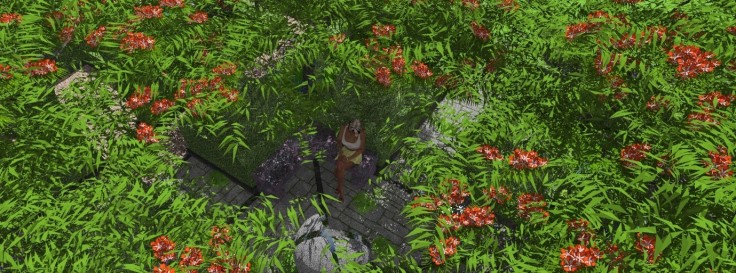
Even though she can be seen from above, if you look hard enough, the seated girl is virtually invisible even from a high vantage point. If she chose to sit on one of the other three seats in the space however, she would be completely concealed from that perspective. At the same time the partial ceiling canopy provides the essential shade that makes a seating space physically comfortable in a Mediterranean or tropical country as well as the desirability of the prospect-refuge psychology.
The secure seating (refuge) space has also been given a strong desirability by a central focal point which reinforces the visual appeal of the refuge space from the prospect space without, but most importantly reinforces the desirability for repose from within. The provision of seating further reinforces this desirability to remain.
Note the linear stone sleepers leading out to the Western prospect that encourage the explorer in that prospect to enter the refuge, and conversely invite the reposer within the refuge to explore the garden beyond. Note also the largish paving elements in the secure (refuge) space that create an illusion of greater space within, when in fact the space is relatively small.
Day and Night: the role of artificial lighting
The prospect-refuge dynamic we have been discussing so far actually gets reversed during the hours of darkness. During daylight the shade of an overhead canopy is eminently desirable, but at night unlit heavily shaded and enclosed spaces have a negative desirability to humans. They represent real and imagined ‘hazards’, or as Appleton put it ‘that which disturbs or threatens the equilibrium’, these are expressed as psychological fears, especially to the female and infant of the species…

In the landscape, be it residential or public, commercial or municipal, if it is envisaged for night time use, lighting is essential. Not just for practicalities and functionality, but to continue the essence of secure space into the night time realm…

Notice that low level lighting does the trick and intensifies the sense of invitation and repose, there is no need for Blackpool illuminations! Indeed, over illumination would have diminished the intimacy and desirability of the space at night while making it less of a refuge because those on the outside in the prospect would see inside more clearly. The general rule of thumb is lower level lighting in the refuge to the prospect.
Nested Refuge Spaces
If we analyse the inside-outside room concepts of landscape and garden design critically we can see that Prospect-Refuge is at work here too.
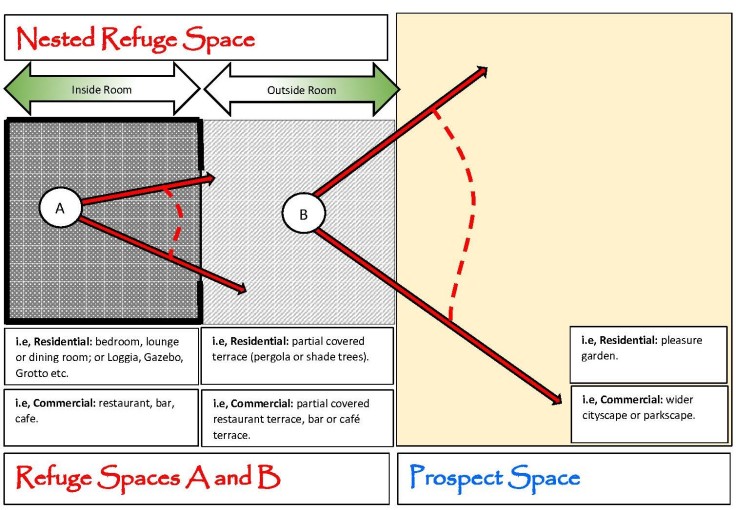
The prospect from Refuge ‘A’ will be cropped by the walls of the architecture, and this can be a reduced panorama or even just a vista to a focal point. Whereas the prospect from Refuge ‘B’ will be a full panorama.
NB: In both cases the quality of the prospect-refuge determines the amount of aesthetic pleasure, received by the users, but in the commercial example given this quality can also be translated to commercial gain. Without delving into the ethics of this as we illustrated with an example earlier from the South of France the commercial gain can be translated to a premium price, which because of the aesthetic certain classes will be prepared to pay; or it can be translated to a desire to spend longer in the aesthetic environment and thus extending sales of drinks and food. This commercial benefit is not limited to bars, cafes and restaurants either, it extends to commercial offices, shops and public facilities of all kinds: gyms, cinemas, museums, galleries, and obviously gardens and parks open to the public.
As is illustrated in the schematic above prospect-refuge concepts can be nested. At our design for the Chick residence in the UK it can be seen that the first level refuge space is fully architectural and within the dwelling – the living room with its large glass terrace door.
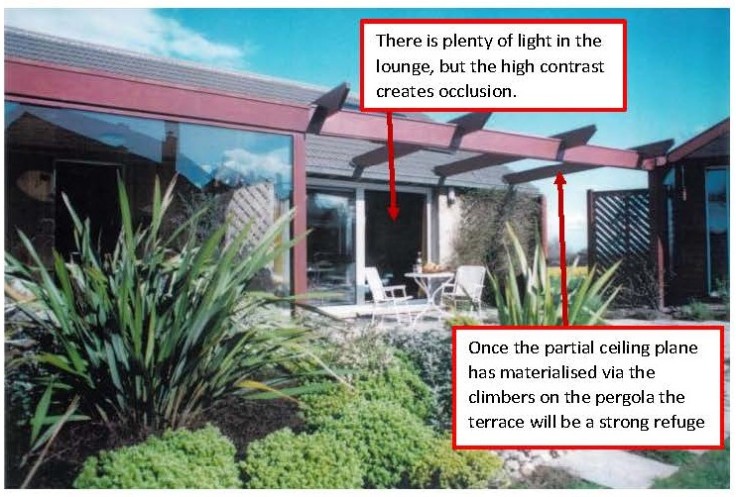
The prospect of the wider landscape visible from the Chick residence lounge is extended when one is on the lounge terrace. The photograph above was taken shortly after practical completion and the partial ceiling plane of the pergola to be realised with a climber via wires between the pergola runners is yet to materialise, but when so the terrace effectively becomes another refuge space. Below is the prospect from the terrace, but as mentioned the occlusion by overhead shade is missing at this time..
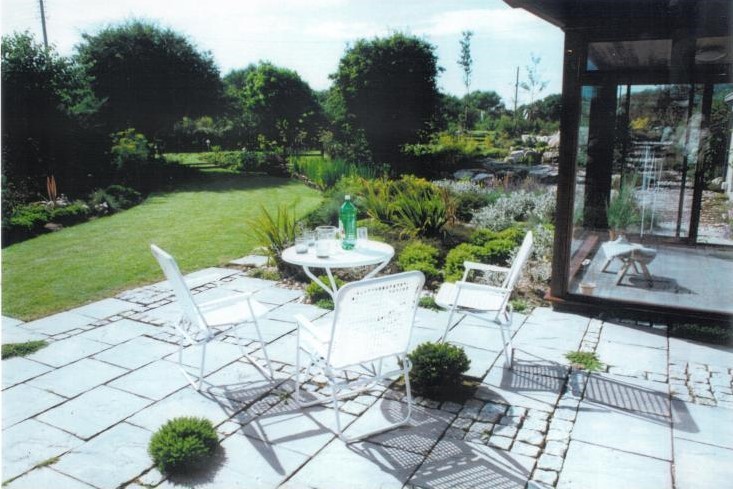
Sub refuge space can be facilitated with residential dwelling spaces as in the Chick garden above, or by: pavilions, loggias, gazebos, and grottos adjoining an exterior refuge space of some formation or another.
The prospect-refuge in the Malgaresh garden illustrated earlier was deliberately designed to be more interesting, and more desirable by integrating a second smaller, and far more intimate sub refuge space within it, in this case a grotto…

In this case unlike the Chick garden the prospect from the grotto is limited to a narrow vista, but on exiting the grotto it expands out into a panoramic as previously illustrated.
In the discussion earlier, I mentioned the relative weighting or strength of the duality between prospect and refuge, and the need to have variety between them in any sequential journey. Below is a second refuge space at Villa Malgaresh, and note that while fulfilling the requirements of prospect-refuge it is relegated to be a weaker refuge in relation to the prospect it affords, and to the other prospect-refuge with the grotto…

In the above second prospect-refuge at Villa Malgaresh the refuge is weaker than its associated prospect, and weaker than the previous refuge at Malgaresh which we illustrated. So the desire to explore the prospect will be greater, while the desire to repose in the refuge will be less…

We can now compare the two different prospect-refuge compositions at Villa Malgaresh we have illustrated to perform a simple analysis to show how the asymmetric balances have been created.
There are many prospect-refuge spaces at Villa Malgaresh beyond the two discussed, and they all link together in the sequential journey. The varying asymmetrical balances in these prospect-refuge dualities creates great interest and varied exciting human emotional experience as one walks around the garden, pausing in the refuge spaces before proceeding to explore more.
Conclusion
As with all landscapes due to the 4th design dimension there is rarely one day the same. Daily change of weather changes each scene, as does the seasonal climate proving once more that landscape design is the greatest art form. Thus, walking the sequential journey is a new experience over time. Users experience all the wonderful emotions from the landscape, but do not consciously realise how ‘designed’ it all is. The good landscape designer must be: an artist, technician, architect and psychologist to creatively compose all of this.
Prospect-refuge is but one of the many underpinning landscape design philosophies. The application of prospect-refuge embraces: both architecture and landscape architecture, residential, public, commercial and municipal projects. As I have demonstrated here, prospect-refuge is a powerful design philosophy in the hands of a professional and creative landscape designer. Like all the landscape design philosophies, and the principles of art, design and composition when understood and utilised creatively, all separate master landscape designers from mediocre ones.
Graham Slocombe © 2019
Additional Link
Prospect-refuge was designed into this community wellness garden for Hodge Hill in Birmingham, England…
See more of Villa Malgaresh…..
Villa Malgaresh Architectural & Garden Design: Nice, France 2007
Other LAC designs with strong Prospect-Refuge….
Jenkins Gite, Brittany….
Jenkins Gite Architectural & Garden Design: Brittany, France, 2000
Shamrockville, Southern Ireland….
Luxury Health Centre, Portugal….
Health Club Architectural and Garden Design: Algarve, Portugal 2013
Additional reading around the topic…..
What is Sense of Place?
What is Sequential Journey?
What is Information-Processing?
Why are we Fascinated by Gardens?
Why employ a professional landscape designer?



